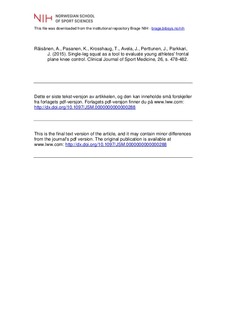| dc.contributor.author | Räisanen, Anu | |
| dc.contributor.author | Pasanen, Kati | |
| dc.contributor.author | Krosshaug, Tron | |
| dc.contributor.author | Avela, Janne | |
| dc.contributor.author | Perttunen, Jarmo | |
| dc.contributor.author | Parkkari, Jari | |
| dc.date.accessioned | 2017-01-24T15:31:42Z | |
| dc.date.available | 2017-01-24T15:31:42Z | |
| dc.date.issued | 2015 | |
| dc.identifier.citation | Clinical Journal of Sport Medicine. 2015, 26, 478-482 | nb_NO |
| dc.identifier.uri | http://hdl.handle.net/11250/2428199 | |
| dc.description | I Brage finner du siste tekst-versjon av artikkelen, og den kan inneholde ubetydelige forskjeller fra forlagets pdf-versjon. Forlagets pdf-versjon finner du på www.lww.com / In Brage you'll find the final text version of the article, and it may contain insignificant differences from the journal's pdf version. The definitive version is available at www.lww.com | nb_NO |
| dc.description.abstract | Objective: To determine the agreement between 2D video analysis and subjective visual assessment by a physiotherapist in evaluating young athletes’ knee control, and to determine the intra- and inter-rater reliability of the single-leg squat test. Design: Frontal plane knee control was assessed by a physiotherapist on a three-point scale. Frontal plane projection angles were calculated from video images. To determine the intra-rater reliability, a physiotherapist re-assessed 60 subjects’ performances from a video. For the inter-rater reliability, 20 subjects were assessed by both the physiotherapist and a non-experienced tester. The study continued for three test years. Setting: Research institute.
Participants: 378 floorball, basketball, ice hockey and volleyball players. Assessment of variables: Knee control was assessed to be good, reduced or poor. Main outcome measures: Agreement between the video analysis and subjectively assessed frontal plane knee control. Intra- and inter-rater reliability. Results: There were statistically significant differences in the mean frontal plane knee angles between subjects rated as having ‘good’, ‘reduced’ or ‘poor’ knee control. Intra-rater reliability was fair for the assessments in the first year, moderate (dominant leg) and good (non-dominant leg) for the second year, and very good (dominant leg) and good (non-dominant leg) for the third year. Inter-rater reliability was fair/poor. Conclusions: This study suggests that by using the subjective assessment of the single-leg squat task, it is possible to detect differences in frontal plane knee control in young team sport athletes. The assessment can be considered to be reliable for clinical use when performed by an experienced tester. | nb_NO |
| dc.language.iso | eng | nb_NO |
| dc.publisher | Lippincott, Williams & Wilkins | nb_NO |
| dc.subject | knee | nb_NO |
| dc.subject | physiotherapist | nb_NO |
| dc.subject | evaluation | nb_NO |
| dc.subject | screening | nb_NO |
| dc.subject | reliability | nb_NO |
| dc.title | Single-leg squat as a tool to evaluate young athletes' frontal plane knee control | nb_NO |
| dc.type | Journal article | nb_NO |
| dc.type | Peer reviewed | nb_NO |
| dc.subject.nsi | VDP::Medisinske Fag: 700::Idrettsmedisinske fag: 850 | nb_NO |
| dc.source.journal | Clinical Journal of Sports Medicine | nb_NO |
| dc.identifier.doi | http://dx.doi.org/10.1097/JSM.0000000000000288 | |
| dc.description.localcode | Seksjon for idrettsmedisinske fag / Department of Sports Medicine | nb_NO |
